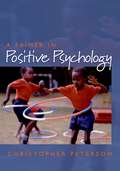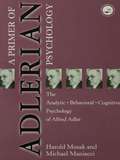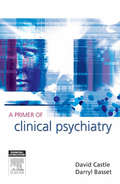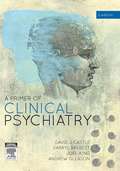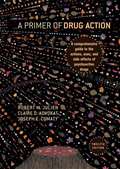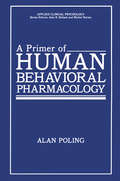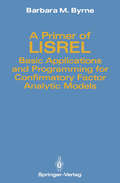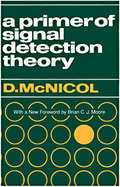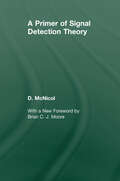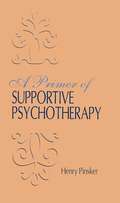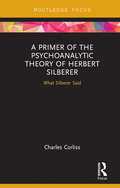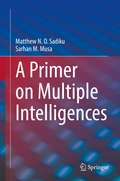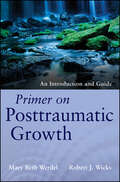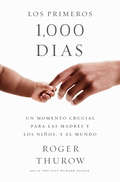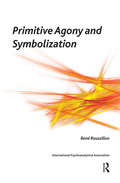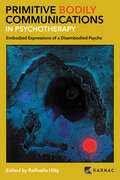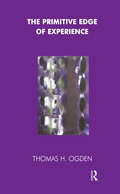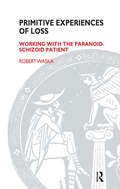- Table View
- List View
A Primer in Positive Psychology (Oxford Positive Psychology Series)
by Christopher PetersonPositive psychology is the scientific study of what goes right in life, from birth to death and at all stops in between. It is a newly-christened approach within psychology that takes seriously the examination of that which makes life most worth living. Everyone's life has peaks and valleys, and positive psychology does not deny the valleys. Its signature premise is more nuanced, but nonetheless important: what is good about life is as genuine as what is bad and, therefore, deserves equal attention from psychologists. Positive psychology as an explicit perspective has existed only since 1998, but enough relevant theory and research now exist to fill a textbook suitable for a semester-long college course. A Primer in Positive Psychology is thoroughly grounded in scientific research and covers major topics of concern to the field: positive experiences such as pleasure and flow; positive traits such as character strengths, values, and talents; and the social institutions that enable these subjects as well as what recent research might contribute to this knowledge. Every chapter contains exercises that illustrate positive psychology, a glossary, suggestions of articles and books for further reading, and lists of films, websites, and popular songs that embody chapter themes. A comprehensive overview of positive psychology by one of the acknowledged leaders in the field, this textbook provides students with a thorough introduction to an important area of psychology.
Primer of Adlerian Psychology: The Analytic - Behavioural - Cognitive Psychology of Alfred Adler
by Harold Mosak Michael ManiacciA Primer of Adlerian Psychology offers an accessible, yet very learned, introduction to Adlerian Psychology. Also known as Individual Psychology, the approach stresses the unity of the individual, the subjective choices he or she makes and the goals the individual works towards he or she moves through life. Therapists can apply this theory in a variety of settings with populations of all ages, making it a highly practical and valuable approach. Written by two scholars with extensive knowledge and experience in this school of thought, this book covers the basic tenets of Individual Psychology geared toward those students and clinicians who are yet unfamiliar with Adler's work.
Primer of Adlerian Psychology: The Analytic - Behavioural - Cognitive Psychology of Alfred Adler
by Harold Mosak Michael ManiacciA Primer of Adlerian Psychology offers an accessible, yet very learned, introduction to Adlerian Psychology. Also known as Individual Psychology, the approach stresses the unity of the individual, the subjective choices he or she makes and the goals the individual works towards he or she moves through life. Therapists can apply this theory in a variety of settings with populations of all ages, making it a highly practical and valuable approach. Written by two scholars with extensive knowledge and experience in this school of thought, this book covers the basic tenets of Individual Psychology geared toward those students and clinicians who are yet unfamiliar with Adler's work.
A Primer of Clinical Psychiatry
by David Castle Darryl BassettThis is a text book of clinical psychiatry that is concise yet comprehensive, up to date, and readily accessible. It aims to be an easy entry to the pertinent facts of clinical psychiatry for medical students and students of mental health disciplines; a resource for established clinicians, including GPs; and also a brief yet thorough overview for the more advanced psychiatric trainee or mental health professional. There is a particular focus on providing simple clinical tips. Liberal use of fact boxes and summary lists ensures readers will have at their fingertips the facts required for undergraduate OSCE exams in clinical psychiatry (an appendix provides explicit examples), as well as equipping more advanced readers with the basic knowledge underpinning post-graduate exams in clinical psychiatry and related allied health disciplines. To effect coherence of approach and minimal overlap between chapters, the bulk of the text has been written by two authors who are experienced psychiatrists with expertise in a broad range of clinical and research areas. Introductory chapters cover the psychiatric interview and mental state and clinical investigations relevant to psychiatry. The second section is an overview of all of the major syndromes of psychiatry, covering epidemiology, aetiology and clinical aspects, and including discussion of specific treatment approaches. A separate section reviews more generally, biological and psychosocial aspects of treatment in psychiatry, with worked case examples.coherence of approach and minimal overlap with specialist material integrated clinical tips and skillscovers clinical and written examination requirementsreferencing WHO, ICD and DSM Va glossary of termsfact boxes and summary lists
A Primer of Clinical Psychiatry
by David Castle Darryl Bassett Joel King Andrew GleasonThe second edition of A Primer of Clinical Psychiatry provides a broad overview of the major topics in psychiatry and provides the clinical skills necessary for competent clinical practice. It also includes an up-to-date overview of the scientific literature behind this fascinating and challenging medical discipline. This book covers in detail the psychiatric interview, the mental state examination, and clinical investigations relevant to psychiatry. All of the major syndromes of psychiatry are addressed including schizophrenia, depressive disorders, bipolar disorder, anxiety, post-traumatic disorders, obsessive-compulsive disorders, eating disorders, somatoform disorders and personality disorders and cover epidemiology, aetiology and clinical aspects, and discussion of specific treatment approaches. A separate section reviews biological and psychosocial aspects of treatment in psychiatry, with worked case examples. A chapter on psychiatric emergencies is included in this section. Discrete chapters cover specialist areas such as child and adolescent psychiatry, old age psychiatry, forensic psychiatry, dual disability and substance use disorders. Enhancing each chapter is a case-based role-play scenario, complete with model answers. Each scenario is set out to model modern pedagogical theory, with roles, setting, tasks, and model answers all articulated and cross-referenced to the core text. Readers can adopt various roles within the scenarios, including that of the doctor (general practice registrars, interns, and residents), allied health staff, or patients themselves and their relatives. The scenarios cover everything from basic skills such as taking a history or describing a disorder, to more advanced problems, such as working with the hostile family and assessing risk in the emergency setting. This case-based role-play approach is ideal for those preparing for psychiatry Observed Structured Clinical Examinations (OSCEs). A Primer of Clinical Psychiatry 2nd edition aims to introduce the pertinent facts of clinical psychiatry to medical students and students of mental health disciplines. It will also be a useful resource for established clinicians, including GPs and the more advanced psychiatric trainee or mental health professional.• Case-based scenarios provide a practical application of theory in real life and are ideal for OSCE preparation.• Drug dosages prescribed for biological treatment of psychiatric diseases add to the clinical aspect of the book• New chapters on the history of psychiatry and ethics in psychiatry have been added to this edition.• The section “How to use this book" helps the reader navigate the book effectively and efficiently.
Primer Of Drug Action
by Robert M. Julien Claire D. Advokat Joseph E. ComatyEdition after edition, Robert Julien’s A Primer of Drug Action keeps pace with one of the most dynamic fields of scientific inquiry, giving students immediate access to the most current research and promising new directions in psychopharmacology. Rigorously updated throughout, the new edition again takes its place as the definitive guide to the drugs that affect the mind and behavior. As always, it is clear, comprehensive, objective, and authoritative, spanning a wide variety of drug types, including sedatives, depressants, stimulants, analgesics, psychedelic drugs, steroids, and drugs used to treat psychological disorders. To visit Robert Julien's blog that accompanies A Primer of Drug Action, click here.
A Primer of Human Behavioral Pharmacology (Nato Science Series B:)
by Alan Polingvii Drugs and sex are two topics about which most people have strong opinions and weak understanding. Knowledge of each can be gained in many ways, all with associated rewards and risks. Like all textbooks, this one was written in the belief that reading can foster learning. The book is intended to introduce principles of behavioral pharmacology to readers with little or no knowledge of the discipline but with an interest in how drugs affect human behavior. Gleaning anything of value from the text requires two things from the reader. The first is a willingness to accept an analysis of drug effects that shares little with folklore or common sense no tions of drug action. The second is a willingness to accept the fact that the behavioral effects of drugs are complex and depend upon a sizable number of pharmacological and behavioral variables. Unless one is aware of these factors and how they determine a drug's actions, the behavioral effects of drugs can be neither pre dicted nor meaningfully explained. If it does nothing else, this volume will make it obvious that the behavioral effects of drugs are lawful and can be predicted and understood on the basis of well-established relations between empirical phenomena. De scribing these relations and exploring how they allow behavioral ix x PREFACE pharmacologists to make sense of drug effects that are otherwise incomprehensible was a major goal in preparing the text.
A Primer of LISREL: Basic Applications and Programming for Confirmatory Factor Analytic Models
by Barbara M. ByrneA Primer of LISREL represents the first complete guide to the use of LISREL computer programming in analyses of covariance structures. Rather than writing for the expert statistician, Dr. Byrne draws examples from her own research in providing a practical guide to applications of LISREL modeling for the unsophisticated user. This book surpasses the other theoretically cumbersome manuals, as the author describes procedures and examples establishing for the user the first book requiring no supplement to the understanding of causal modeling and LISREL.
A Primer of Signal Detection Theory
by Don McNicolA Primer of Signal Detection Theory is being reprinted to fill the gap in literature on Signal Detection Theory--a theory that is still important in psychology, hearing, vision, audiology, and related subjects. This book is intended to present the methods of Signal Detection Theory to a person with a basic mathematical background. It assumes knowledge only of elementary algebra and elementary statistics. Symbols and terminology are kept at a basic level so that the eventual and hoped for transfer to a more advanced text will be accomplished as easily as possible. Intended for undergraduate students at an introductory level, the book is divided into two sections. The first part introduces the basic ideas of detection theory and its fundamental measures. Its aim is to enable the reader to be able to understand and compute these measures. It concludes with a detailed analysis of a typical experiment and a discussion of some of the problems which can arise for the potential user of detection theory. The second section considers three more advanced topics: threshold theory, the extension of detection theory, and an examination of Thurstonian scaling procedures.
A Primer of Signal Detection Theory
by Don McNicolA Primer of Signal Detection Theory is being reprinted to fill the gap in literature on Signal Detection Theory--a theory that is still important in psychology, hearing, vision, audiology, and related subjects. This book is intended to present the methods of Signal Detection Theory to a person with a basic mathematical background. It assumes knowledge only of elementary algebra and elementary statistics. Symbols and terminology are kept at a basic level so that the eventual and hoped for transfer to a more advanced text will be accomplished as easily as possible. Intended for undergraduate students at an introductory level, the book is divided into two sections. The first part introduces the basic ideas of detection theory and its fundamental measures. Its aim is to enable the reader to be able to understand and compute these measures. It concludes with a detailed analysis of a typical experiment and a discussion of some of the problems which can arise for the potential user of detection theory. The second section considers three more advanced topics: threshold theory, the extension of detection theory, and an examination of Thurstonian scaling procedures.
A Primer of Supportive Psychotherapy
by Henry PinskerFor many patients, supportive therapy is the treatment of choice, and for many others, the use of medications or of more expressive techniques optimally occurs in the context of a supportive relationship. Yet, there is a paucity of literature expressly devoted to the techniques and aims of supportive psychotherapy. In A Primer of Supportive Psychotherapy, Henry Pinsker remedies this situation by focusing directly on the rationale for, and techniques of, supportive psychotherapy. He explores this modality as a form of dyadic intervention quite distinct from expressive psychotherapies, and also shows how, to varying extents, supportive psychotherapy makes use of patterns of relationships and behavior, past and present. Pinsker's writing is wise, human, and direct. The realities, ironies, conundrums, and opportunities of the therapeutic encounter are vividly portrayed in scores of illustrative dialogues drawn from actual treatments. Destined to become the classic introductory work in the field, A Primer of Supportive Psychotherapy will be valued by students and trainees in all mental health disciplines--and by their teachers--for its wealth of practical guidelines and explicit instruction on how to develop, maintain, and make optimal therapeutic use of a supportive relationship. Psychopharmacologists, counselors, nurse practitioners, and primary care physicians are among the helping professionals who will likewise benefit from Pinsker's clear presentation of the principles of supportive work. Beyond its didactic value, this text will be an indispensable conceptual touchstone for any clinician interested in understanding more clearly the differences among various interventional modalities as a preliminary step in optimal treatment planning.
A Primer of Supportive Psychotherapy
by Henry PinskerFor many patients, supportive therapy is the treatment of choice, and for many others, the use of medications or of more expressive techniques optimally occurs in the context of a supportive relationship. Yet, there is a paucity of literature expressly devoted to the techniques and aims of supportive psychotherapy. In A Primer of Supportive Psychotherapy, Henry Pinsker remedies this situation by focusing directly on the rationale for, and techniques of, supportive psychotherapy. He explores this modality as a form of dyadic intervention quite distinct from expressive psychotherapies, and also shows how, to varying extents, supportive psychotherapy makes use of patterns of relationships and behavior, past and present. Pinsker's writing is wise, human, and direct. The realities, ironies, conundrums, and opportunities of the therapeutic encounter are vividly portrayed in scores of illustrative dialogues drawn from actual treatments. Destined to become the classic introductory work in the field, A Primer of Supportive Psychotherapy will be valued by students and trainees in all mental health disciplines--and by their teachers--for its wealth of practical guidelines and explicit instruction on how to develop, maintain, and make optimal therapeutic use of a supportive relationship. Psychopharmacologists, counselors, nurse practitioners, and primary care physicians are among the helping professionals who will likewise benefit from Pinsker's clear presentation of the principles of supportive work. Beyond its didactic value, this text will be an indispensable conceptual touchstone for any clinician interested in understanding more clearly the differences among various interventional modalities as a preliminary step in optimal treatment planning.
A Primer of the Psychoanalytic Theory of Herbert Silberer: What Silberer Said (Routledge Focus on Analytical Psychology)
by Charles CorlissHerbert Silberer was an early member of Freud’s Vienna Group whose work was unique and prodigious; yet, owing to his expulsion from the psychoanalytic community, his contributions have been dismissed for close to a century. Based on original documents and primary sources, A Primer of the Psychoanalytic Theory of Herbert Silberer: What Silberer Said recovers the psychoanalytic theory of Herbert Silberer, revealing its connections to philosophy, theology and transcendence, and examining how his writings influenced C. G. Jung. The book begins with an overview of what is known of Silberer’s life, before commencing with an exploration of his writings. Charles Corliss covers topics including Silberer’s groundbreaking construct of the hypnagogic phenomenon, the process and meaning of symbolism and symbol formation, alchemy and its connection to his major work Problems of Mysticism and Symbolism, the use of symbols in Freemasonry and his influential understanding of dreams and their meaning. The book also explores Silberer’s complex relationship with the field of psychoanalysis, including his opposition to many psychoanalytic assumptions. Introducing and assessing the main contributions of Silberer’s work, this book will be of interest to analytical psychologists and Jungian psychotherapists in practice and training, as well as to academics and students of Jungian studies and the history of psychoanalysis, psychoanalytic studies, theology, philosophy and the history of psychology.
A Primer of the Psychoanalytic Theory of Herbert Silberer: What Silberer Said (Routledge Focus on Analytical Psychology)
by Charles CorlissHerbert Silberer was an early member of Freud’s Vienna Group whose work was unique and prodigious; yet, owing to his expulsion from the psychoanalytic community, his contributions have been dismissed for close to a century. Based on original documents and primary sources, A Primer of the Psychoanalytic Theory of Herbert Silberer: What Silberer Said recovers the psychoanalytic theory of Herbert Silberer, revealing its connections to philosophy, theology and transcendence, and examining how his writings influenced C. G. Jung. The book begins with an overview of what is known of Silberer’s life, before commencing with an exploration of his writings. Charles Corliss covers topics including Silberer’s groundbreaking construct of the hypnagogic phenomenon, the process and meaning of symbolism and symbol formation, alchemy and its connection to his major work Problems of Mysticism and Symbolism, the use of symbols in Freemasonry and his influential understanding of dreams and their meaning. The book also explores Silberer’s complex relationship with the field of psychoanalysis, including his opposition to many psychoanalytic assumptions. Introducing and assessing the main contributions of Silberer’s work, this book will be of interest to analytical psychologists and Jungian psychotherapists in practice and training, as well as to academics and students of Jungian studies and the history of psychoanalysis, psychoanalytic studies, theology, philosophy and the history of psychology.
A Primer on Multiple Intelligences
by Sarhan M. Musa Matthew N. SadikuThis book provides an introduction to nineteen popular multiple intelligences. Part One discusses general intelligence, psychological testing, naturalistic intelligence, social intelligence, emotional intelligence, interpersonal intelligence, and cultural intelligence. Part Two tackles machine intelligence, the development of artificial intelligence, computational intelligence, and digital intelligence, or the ability for humans to adapt to a digital environment. Finally, Part Three discusses the role of intelligence in business development, using technology to augment intelligence, abstract thinking, swarm and animal intelligence, military intelligence, and musical intelligence. A Primer on Multiple Intelligences is a must-read for graduate students or scholars considering researching cognition, perception, motivation, and artificial intelligence. It will also be of use to those in social psychology, computer science, and pedagogy. It is as a valuable resource for anyone interested in learning more about the multifaceted study of intelligence.
Primer on Posttraumatic Growth: An Introduction and Guide
by Mary Beth Werdel Robert J. Wicks"From the inspiring chapter quotes, to relevant historical and current research, to practical clinical directions, Primer on Posttraumatic Growth takes a giant step toward both grounding us and moving us ahead with strong hope for adjustment and growth in the post-trauma/loss world. This is a comprehensive, practical, and readable work that should be at hand for any mental health clinician, pastoral care professional, or student preparing for these professions." —J. Shep Jeffreys, EdD, FT, author of Helping Grieving People—When Tears Are Not Enough: A Handbook for Care Providers, Second Edition A guide for helping your clients overcome negative events, based on the latest research on posttraumatic growth Drawing on the growing empirical and theoretical material on posttraumatic growth—an outgrowth of the positive psychology movement—Primer on Posttraumatic Growth provides insight, depth, and treatment recommendations for both the clinicians who work with those who have experienced dramatic negative events in their lives and for other professionals who support victims of trauma and extreme stress. This essential primer examines: The connections between meaning and growth The impact of cognitive processing on posttraumatic growth Positive emotion and posttraumatic growth Posttraumatic growth and an "open" personality The human drive to be in positive and important interpersonal relationships Forgiveness: can it be extended towards all areas of posttraumatic growth? Posttraumatic growth and religious and spiritual variables Wisdom and posttraumatic growth
Primer on Posttraumatic Growth: An Introduction and Guide
by Mary Beth Werdel Robert J. Wicks"From the inspiring chapter quotes, to relevant historical and current research, to practical clinical directions, Primer on Posttraumatic Growth takes a giant step toward both grounding us and moving us ahead with strong hope for adjustment and growth in the post-trauma/loss world. This is a comprehensive, practical, and readable work that should be at hand for any mental health clinician, pastoral care professional, or student preparing for these professions." —J. Shep Jeffreys, EdD, FT, author of Helping Grieving People—When Tears Are Not Enough: A Handbook for Care Providers, Second Edition A guide for helping your clients overcome negative events, based on the latest research on posttraumatic growth Drawing on the growing empirical and theoretical material on posttraumatic growth—an outgrowth of the positive psychology movement—Primer on Posttraumatic Growth provides insight, depth, and treatment recommendations for both the clinicians who work with those who have experienced dramatic negative events in their lives and for other professionals who support victims of trauma and extreme stress. This essential primer examines: The connections between meaning and growth The impact of cognitive processing on posttraumatic growth Positive emotion and posttraumatic growth Posttraumatic growth and an "open" personality The human drive to be in positive and important interpersonal relationships Forgiveness: can it be extended towards all areas of posttraumatic growth? Posttraumatic growth and religious and spiritual variables Wisdom and posttraumatic growth
Los primeros 1000 dias: A Crucial Time for Mothers and Children -- And the World
by Roger Thurow&“Su hijo puede lograr grandes cosas&”. Hace unos años, mujeres embarazadas en cuatro rincones del mundo escucharon esas palabras y esperaban que pudieran ser ciertas. Entre ellas, Esther, de la zona rural de Uganda; Jessica, de un vecindario de Chicago marcado por la violencia; Shyamkali, de una aldea de casta baja en India; y María Estela, del altiplano occidental de Guatemala. Alcanzar la grandeza fue un pensamiento audaz, pero las mujeres tenían una nueva causa para tener esperanza: estaban participando en una iniciativa internacional sin precedentes enfocada en proporcionar una nutrición adecuada durante los primeros mil días de vida de los niños, comenzando desde el embarazo de estas madres. El movimiento 1000 Días, que es una respuesta a las recientes crisis alimentarias devastadoras y las nuevas investigaciones sobre los costos económicos y sociales del hambre y el retraso en el crecimiento infantil, tiene el poder para transformar las vidas de madres e hijos, y finalmente, del mundo. En este libro inspirador, a veces desgarrador, Roger Thurow nos adentra en la vida de las familias al frente del movimiento en una íntima narrativa que ilumina la ciencia, la economía y la política de la desnutrición, registrando el emocionante progreso y los formidables desafíos de este esfuerzo global.
Primitive Agony and Symbolization (The International Psychoanalytical Association Psychoanalytic Ideas and Applications Series)
by Rene RoussillonThe fundamental outlook of this book is clinical. It attempts to establish a unitary model of the processes at work in different forms of narcissistic pathology, and to offer a model that is both an alternative to, and complementary to, Freud's model of what are usually considered to be neurotic problems. The aim is to extract a sequence of mental processes that could be seen as typical of narcissistic disturbances of the sense of identity, with their several forms and clinical variations. The book describes how these are structured, together with their intrapsychic and intersubjective functions, based on the hypothesis of a defensive pattern that is set up to counter the effect of a split-off primary trauma and the threat that hangs over the mind and subjectivity.
Primitive Agony and Symbolization (The International Psychoanalytical Association Psychoanalytic Ideas and Applications Series)
by Rene RoussillonThe fundamental outlook of this book is clinical. It attempts to establish a unitary model of the processes at work in different forms of narcissistic pathology, and to offer a model that is both an alternative to, and complementary to, Freud's model of what are usually considered to be neurotic problems. The aim is to extract a sequence of mental processes that could be seen as typical of narcissistic disturbances of the sense of identity, with their several forms and clinical variations. The book describes how these are structured, together with their intrapsychic and intersubjective functions, based on the hypothesis of a defensive pattern that is set up to counter the effect of a split-off primary trauma and the threat that hangs over the mind and subjectivity.
Primitive Bodily Communications in Psychotherapy: Embodied Expressions of a Disembodied Psyche
by Raffaella HiltyEvery psychotherapist will be familiar with what it means to experience the hatred and despair of their most vulnerable patients in the midst of a psychotherapy session. Most often these patients will manage to express their feelings verbally, but what about those who never developed the capacity to speak? Or those who are capable of talking, but carry a complex range of unprocessed embodied feelings that cannot be verbally expressed? Some patients must rely on another type of language in order to communicate their dissociative states of mind. Primitive Bodily Communications explores how the ‘talking cure’ can still work when words fail and the body ‘talks.’ Non-verbal communication can be thought of as a form of body language and, even though this is a topic not frequently discussed, many practitioners have experienced working with people who communicate through the use of their bodies. The book does not refer to bodily communications as primitive because we see them as inferior to verbal language, but simply because they point to the beginnings of psychological development, to primary ways of being and relating, as well as to enduring aspects of ourselves. The contributors explore the topic of primitive bodily communications in the context of intellectual disability, eating disorders and bodily neglect, focusing on the communicative aspect of bodily expressions within the therapeutic relationship. A wide spectrum of clinical cases illustrates how these patients can reach a state of better physical and emotional containment and, when possible, of verbal communication.
The Primitive Edge of Experience
by Thomas OgdenThis book is concerned with the primitive edge of human experience. It explores the idea that human experience is the product of the dialectical interplay of three modes of generating experience: the depressive, the paranoid-schizoid, and the autistic-contiguous.
The Primitive Edge of Experience
by Thomas OgdenThis book is concerned with the primitive edge of human experience. It explores the idea that human experience is the product of the dialectical interplay of three modes of generating experience: the depressive, the paranoid-schizoid, and the autistic-contiguous.
Primitive Experiences of Loss: Working with the Paranoid-Schizoid Patient
by Robert WaskaTaking as his starting point Melanie Klein's concept of the paranoid-schizoid position, and succinctly reviewing subsequent developments within the Kleinian perspective, the author formulates a distinctive and subtle argument concentrated on the topic of primitive loss. It is the author's conviction that the experience of loss has a primacy within the paranoid-schizoid position but that this has received insufficient and inadequate recognition, with significant implications for analytic technique. With this standpoint as his orienting focus, the author provides a finely-textured and penetrating discussion of such issues as projective identification, symbolization, transference and counter transference. A thoughtful and perceptive examination of theoretical issues is buttressed with substantial illustrative case material throughout. Calling for further work to be done in refining and clarifying the understanding of loss, and its intrapsychic, interpersonal and technical ramifications, the present volume represents a significant contribution and stimulus to that task
Primitive Experiences of Loss: Working with the Paranoid-Schizoid Patient
by Robert WaskaTaking as his starting point Melanie Klein's concept of the paranoid-schizoid position, and succinctly reviewing subsequent developments within the Kleinian perspective, the author formulates a distinctive and subtle argument concentrated on the topic of primitive loss. It is the author's conviction that the experience of loss has a primacy within the paranoid-schizoid position but that this has received insufficient and inadequate recognition, with significant implications for analytic technique. With this standpoint as his orienting focus, the author provides a finely-textured and penetrating discussion of such issues as projective identification, symbolization, transference and counter transference. A thoughtful and perceptive examination of theoretical issues is buttressed with substantial illustrative case material throughout. Calling for further work to be done in refining and clarifying the understanding of loss, and its intrapsychic, interpersonal and technical ramifications, the present volume represents a significant contribution and stimulus to that task
